Body condition score for dogs is a more accurate way of determining if your dog is in ideal, overweight, obese or morbidly obese condition without the use of weight charts, or even weighing scales.
Body condition score (BCS) is either done on a score of 1-9 or on a score of 1-5. And in either scales, the system works on the same principle. For the sake of explanation, in this blog we will be using a 5 point scoring system.
What does the Body condition score tell me?
The body condition score tells you if your dog’s body is the right condition for his/ her height, build and structure. What this system allows you to examine for yourself is if your dog is packing on extra fat in certain areas of their body? Is your dog really muscular and therefore looks larger than the rest of his breed? Or is your dog, smaller than the rest, but has the tendency to gain weight and look a little bulky. Whatever the case may be, this system will let you see if your dog is underweight, ideal or overweight and to what extent. A number on the weighing scale can be misleading(Click here), but the BCS system will tell you instantly if the weight is due to excess fat, muscles, heavy bones or just loose skin.
How do I know if the body condition score is accurate?
The accuracy of the BCS system is based YOUR honesty to YOURSELF. So in a way, the accuracy of this system is entirely in your hands. The way this works is, all dogs, regardless of breed are meant to have a certain “look” about them. For instance, all dogs have a deep rib cage that curves upwards towards the hind legs – how deep depends on the breed itself, and the angle of the curve upwards also is breed dependent. Some dogs like the Mudhol hound will have a very exaggerated deep rib cage and a steep angled curve up to the abdomen. Where as a bull dog will have a relatively shallow rib cage and a not so steep curve upwards. But BOTH dogs are meant to have the curve.
Then there is a “feel” test. When you palpate your dog to feel for the ribs. Whether or not you can feel each individual rib or not, is determined by how much fat cover is there on the ribs. In an IDEAL body type, you should be able to feel all the ribs with a slight fat cover on top. In obese dogs, this will be impossible to do. In overweight dogs, you may know that there are ribs under there, but won’t be able to feel each of them individually depending on how much fat cover is on them.
So to answer the question, let your hands, fingers and eyes tell you the truth about how much fat there is on your dog’s body, and this system can be pretty darn accurate!
How do I use the body condition scoring system?

Start with your dog in a relaxed mood, standing in front of you. Look at your dog from the top like a bird’s eye view. What you “should” see in an IDEAL dog is a slender neck (barring loose skin and fur) curving gently outwards to the shoulder blades, a nice slender rounding of the rib cage, curving inwards at the end of the ribs like a waistline, and then curving outwards for the hip joint.
Then look at your dog’s body in profile view. All dogs as mentioned above have a depth to their rib cage that then tilts upwards towards the hind legs. In an IDEAL body you will see the sternum (Breast plate) without too much bulge, the line then flows down the centre of the rib cage to the deepest part of it. And then turns upwards towards the hind legs. The angle of this upward tuck will depend on the breed, but it does need to go upwards and tuck in nice and tight.
For the feel test, start with your dog standing next to you while you kneel down on either side of their body. It is important to have your dog relaxed and willing to stand there while you do this, so if need be, get someone to help you, They can sit in front of them, feeding them some treats in a calm manner.
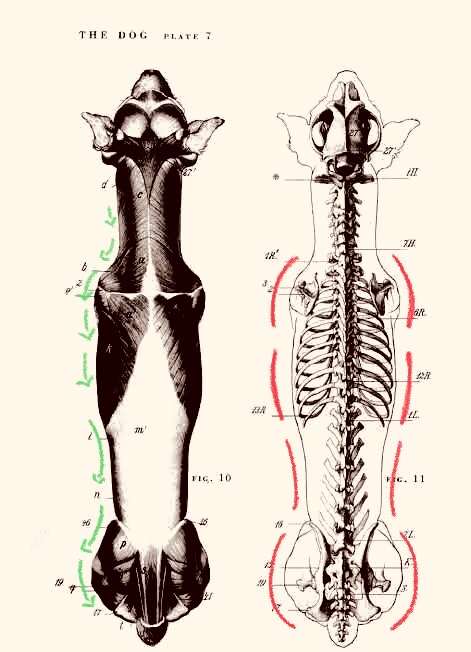
You can then start with your palm on the sternum(breast plate) and feel for fat deposits. Glide your hand over the shoulder joint, back towards the side of the ribs. Now use your fingers to palpate and feel for the ribs. In an IDEAL dog, it will be very easy to feel each rib and your fingers with “fall” into the dips between the ribs. As your hands continue to the back of the body… your hand should fall in the dip at the end of the rib cage, and there should be a slight inward curve between the end of the rib cage and the hip bones. Repeat on both sides. Feel the underbody of the rib cage to feel for extra fat deposits, you should ideally feel the flat hardness with mild cushioning on the rib joint.
How often do I need to do this for my dog?
Since you do not need to leave your home to do this, you could actually make a weekly or fortnightly habit of it. Another personal tip I can give is, bring out the measure tape, and measure your dog at 3 strategic points, and repeat this along with the body condition scoring every fortnight or monthly. Ensure that the tape is not squeezing too tight, nor is it too loose. I should be a nice snug fit. Get someone to take a video of you doing this so that you can repeat your own steps next month.
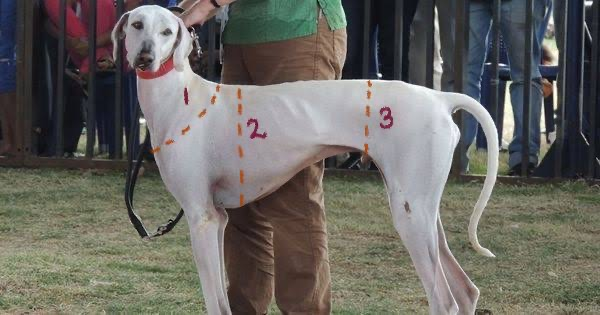
- A broad circle around the sternum and shoulders.
- Around the deepest section of the rib cage
- And just in front of the hind legs – where it should be the narrowest portion of the girth. It need not be right now – but it’s meant to be.
If you are doing all of these steps, I am confident that you will take further steps to ensure your dog DOES get into the IDEAL body shape. It possibly could be the best gift you could give your dog!
My dog has a BCS score of 1 or 2!
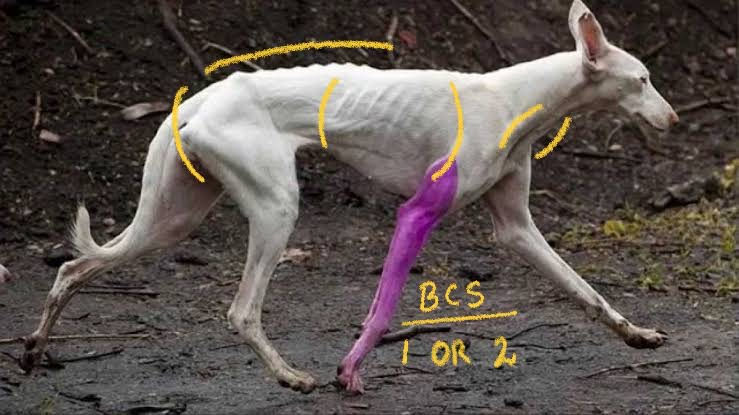
If your dog’s ribs and every vertebra of the spinal cord and the hip bones are jutting out and there is very little mass covering the skeletal system, then your dog is severely underweight and may fall into the BCS score of 1 which could be about 20% – 25% under ideal body condition. Many of us would have seen this in malnourished dogs in rescue cases.
If your dog has visible ribs and hip bones and very little palpable fat and low mass of lean muscle, then your dog might have a body condition score of 2 which could mean about 10-15% under ideal body condition.
The best course of action is NOT to start feeding your dog a lot. Chances are that you are already feeding your dog adequately, and if your dog is still between 10-25% under weight, then there could be an underlying medical condition. Get in touch with a holistic practitioner, and a holistic nutritionist to look at options on what can be done to help your dog. And while it’s very true that several parasites in the gut, severe bowel inflammation and several other medical conditions could be the root cause of this, it is also equally true that a stressful environment could cause this also. To read more about stress and behavior click here.
My dog has a score of 3…!

If a nice abdominal tuck can be seen from the side view, and a lean, hourglass shape can be seen from the top, and your dog’s ribs can be felt with a thin layer of fat then your dog has a BCS of 3, which is the ideal body shape. SO well done! NO matter your dog’s current age, the lifelong aim is to maintain the body shape. Remember, over exercising causes inflammation, and starts retaining weight. Not to mention the stress it puts on the joints causing Arthritis (Click here to read more)
My dog has a score of 4, 5 or 5++. What do I do next?
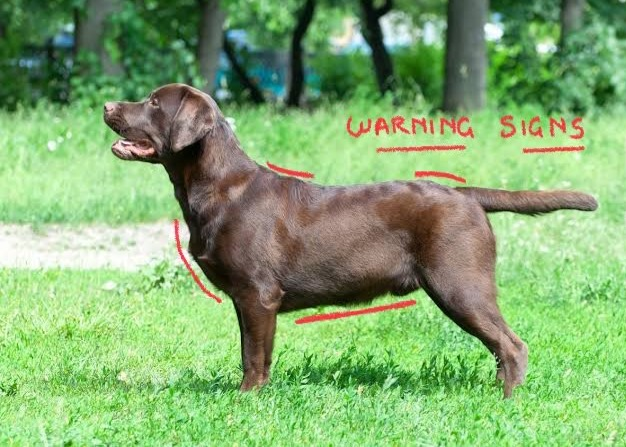
If your dog’s ribs are difficult to feel under a moderate amount of fat. If the tail base can be felt but has substantial fat over it, if there is no abdominal tuck from the side and if the back is broadened at the waist then the dog’s BCS is considered to be a 4. This could mean 10-15% over ideal weight.
This is a point at which immediate action can help your dog from piling on more weight and making everything worse. It is no secret to anyone what vast variety of havoc excess weight causes in the body. The point of failure is to recognize the excess weight at all! NUTRITION is the key. Please DO NOT start your dog on an exercise routine (Click here) that will only hurt their overloaded joints.

If your dog’s ribs are difficult to feel under thick fat cover, if the tail base is difficult to feel under thick fat cover, If there is no waist from the side view and the fat hangs from the abdomen, and the back is visibly broad with no waist at all then the BCS would be 5. This could mean 20-25% over ideal weight. This is categorized as Obese. And 5+ would be severely obese. 5++ would be morbidly obese. At these points your dog most likely has difficulty moving around and perhaps experiences stiffness in joints. Looking at holistically reducing this weight with a detailed plan in place should be of the highest priority now.
Conclusion:
It would be a great idea for everyone to give it a try. Find your dog in a calm and comfortable mood and sit down with them (rather than lean over him/her) and try to feel gently for the ribs. Be careful not to press too hard or poke. When the dog is standing, try to take a look at the side view and see what kind of abdominal tuck you see & then finally stand up and take a top view look at your dog’s back and look at the ribs and waist and back line. Compare your findings with the Body condition scoring system chart.
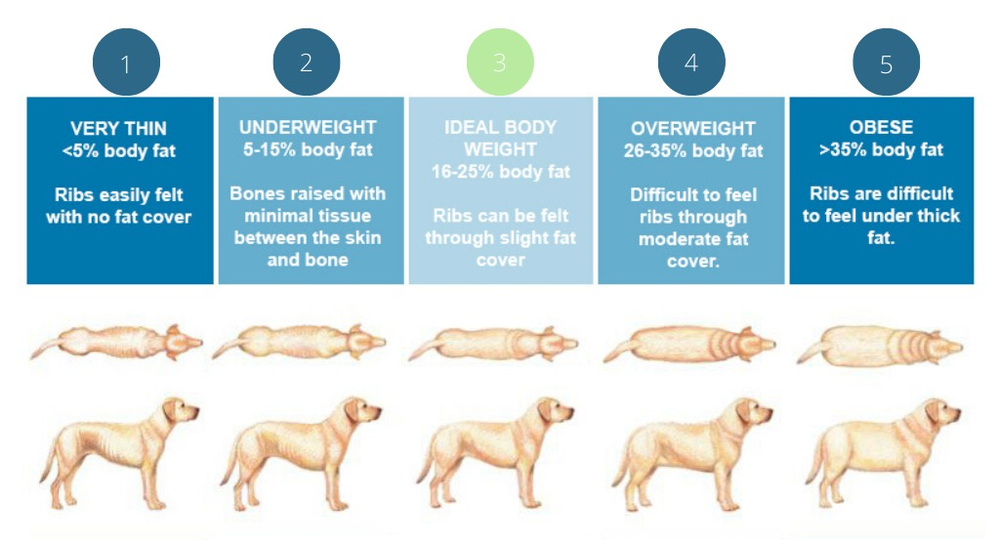
It is needless to say that your dog needs attention if they get a score of 1 or 2, but since we are looking at overweight issues here, we will not be getting into the details of score 1 & 2. But if your dog indeed scores a 1 or 2, please feel free to reach out to a holistic nutritionist for help.
And if your dog gets a score of 3 then it’s perfect – Perform the BCS check every month to ensure you are still on track.
Scores of 3++, 4, 4+ and 5, 5+ and 5++ need immediate attention and changes in nutrition to shed those extra kilos right away. The list of health risks in keeping that extra weight is too long to ignore! (Click here)
I am sure many of us know plenty of dogs that fall into the 3++ to 5++ scores. Share this article with them, help them help their dogs.
Did you perform the Body Condition Scoring on your dog? Tell us your results here.

